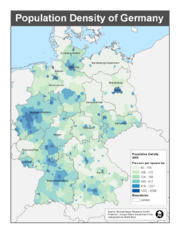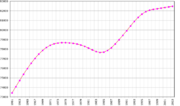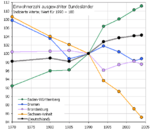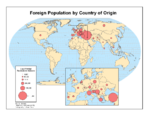Demographics of Germany



The demography of the Federal Republic of Germany is monitored by the "Statistisches Bundesamt" (Federal Statistical Office of Germany). The population of Germany is approximately 82,220,000, making it the 14th most populous country in the world. Germany's population is characterized by zero or declining growth [1], with an aging population and smaller cohort of youths.
More than 16 million people are of non-German descent (first and second generation, including mixed heritage), about seven million of which are foreign residents. The largest ethnic group of non-German origin are the Turkish. Since the 1960s, West and later reunified Germany has been attracting migrants primarily from Southern and Eastern Europe as well as Turkey, many of which (or their children) over time acquired German citizenship. While most of these migrations had an economic background, Germany has also been a prime destination for refugees from many developing countries, in part because its constitution long had a clause giving a 'right' to political asylum, but restrictions over the years have since made it less attractive.
Within Germany, there is a long history of East-to-West migrations, starting with the 19th century Ostflucht. After the World War II border shifts and expulsions, the Germans from Eastern Europe and the former eastern territories moved westward to post-war Germany. During the partition of Germany, many Germans from East Germany fled to West Germany for political and also economic reasons. Since Germany's reunification, there are ongoing migrations from the eastern New Länder to the western Old Länder for economic reasons.
Germany has one of the world's highest levels of education, technological development, and economic productivity. Since the end of World War II, the number of students entering universities has more than tripled, and the trade and technical schools are among the world's best. With a per capita income of about $27,000, Germany is a broadly middle class society. Germans also are very mobile; millions travel abroad each year. A generous social welfare system provides for universal health care, unemployment compensation, and other social needs. Due to Germany's aging population and struggling economy, the welfare system came under a lot of strain from the 1990s. This led the government to push through a wide-ranging programme of belt-tightening reforms, Agenda 2010, including the labour market reforms known as Hartz I - IV.
Contents |
Major metropolitan areas
In 2005 Germany had 82 cities with more than 100,000 inhabitants.
| City name | Location | Description | Population (2004) | Largest German ethnic groups | Largest non-German ethnic groups |
|---|---|---|---|---|---|
| Rhine-Ruhr Metropolitan Region |  |
Cologne is the largest and unofficial capital city of the Rhineland, the very Western part of Germany. Particularly among young Germans, Cologne is renowned for its nightlife and open-minded atmosphere. | 10.2 million | Rhinelanders, Westfalians and others | Turks, Poles, Italians, Dutch, French, Arabs, Iranians, South Asians like Indians, and Japanese (large Japanese community in Düsseldorf). |
| Frankfurt Rhine-Main Region |  |
Frankfurt is the economic and financial center both for Germany and the continental European Union. Frankfurt is arguably Germany's most international city. It boasts a large airport and numerous skyscrapers. Within Germany, the city has a reputation of being very business-oriented, perhaps at the expense of other pursuits. | 5.8 million | Hessians and others | Turks, Italians, Arabs, Iranians, Greeks, Russians, Poles, Israelis, Koreans, and Pakistanis (mostly Pashtun & Panjabi's ethnic groups). |
| Munich Metropolitan Region |  |
Munich has Germany's highest standard of living. Countless sporting and leisure opportunities - both in the city and in its picturesque region. Munich is a powerhouse of the German economy and rich in Bavarian culture. | 4.7 million | Bavarians, Franconians and others | Turks, Croats, Serbs, Greeks, Albanians, Macedonians, Italians, Bosnians, Hungarians, Spaniards and Romanians. |
| Berlin/Brandenburg Metropolitan Region |  |
Berlin is the capital of Germany and its largest city. Berlin lies in the eastern part of the country and has a reputation for cosmopolitan lifestyle, the German "city that never sleeps". But the city still has a high unemployment rate and high poverty. | 4.3 million | Berliners, Brandenburgians and others | Turks, Arabs, Poles, Russians, Albanians, Serbs,Macedonians, Vietnamese, Chinese, rising number of Africans, Chileans and other Latin Americans. |
| Hamburg Metropolitan Region |  |
Hamburg has a long tradition for sea trade and civil establishment. Hamburg is proud of its sophisticated bar and music scene and its reputation as Germany's "capital of good taste". | 4.3 million | Lower Saxons and others | Turks, Russians, Albanians, Poles, Pakistanis, Iranians, Macedonians, Portuguese, Czechs and Slovaks. |
| Leipzig-Halle-Dresden (Saxon Triangle) |  |
Also dubbed "City of Heroes", Leipzig is where the 1989 revolution that brought down the Berlin Wall started. Today totally refurbished, it sports Europe's highest density of Art Nouveau architecture. Very lively bar scene, fastest growing economy in Germany. | 3.5 million | Saxons and others | Vietnamese, Poles, Russians, Portuguese, Italians, Iranians, Turks, Arabs, Indians and Pakistanis. |
| Stuttgart Metropolitan Region |  |
Stuttgart has a reputation for research, inventions and industry. The German headquarters of many international enterprises are in Stuttgart. This contrasts with the strong rural, down-to-earth attitude of the Stuttgarters throughout the classes. A popular slogan is "We are good at everything. Except speaking High (standard) German." | 3.5 million | Swabians and others | Turks, Greeks, Italians, Croats, Serbs, French, Chinese, Romanians, Americans and Spaniards. |
| Bremen/Oldenburg Metropolitan Region |  |
- | 2.4 million | Lower Saxons, Frisians and others | Turks, Russians, Poles, Albanians, Serbs, Portuguese, Iranians, Dutch, Americans and Britons. |
Groups by Citizenship
In 2007:
- Total population = 82,210,894
- German = (91.2%) 74,969,842
- Turkish = (2.1%) 1,713,551
- Other = (6.7%) 5,527,501 (including Italian (528,318), Polish (384,808) and other)
Four other sizable groups of people are referred to as "national minorities" (nationale Minderheiten) because they have lived in their respective regions for centuries: Danes, Frisians, Roma and Sinti, and Sorbs.
There is a Danish minority (about 50,000, according to government sources) in the northern-most state of Schleswig-Holstein.
Eastern and Northern Frisians live at Schleswig-Holstein's western coast, and in the north-western part of Lower Saxony. They are part of a wider community (Frisia) stretching from Germany to the northern Netherlands.
The Sorbs, a Slavic people with about 60,000 members (according to government sources), are located in the Lusatia region of Saxony and Brandenburg. They are the last remnants of the Slavs that lived in central and eastern Germany since the 7th century.
Roma people have been in Germany since the Middle Ages. They were persecuted by the Nazis, and thousands of Roma living in Germany were killed by the Nazi regime. Nowadays, they are spread all over Germany, mostly living in major cities. It is difficult to estimate their exact number, as the German government normally does not keep information on the ethnicity of its citizens. There are also many assimilated Sinti and Roma. A vague figure given by the German Department of the Interior is about 70,000. In the 1990s, many Roma moved to Germany from former Yugoslavia. In contrast to the old-established Roma population, the majority of them do not have German citizenship, they are classified as immigrants or refugees.
After World War II, there was an influx of 14 million ethnic Germans from Eastern Europe who were expelled or fled after Germany lost the war.
Since the 1960s, ethnic Germans from the Soviet Union have come to Germany, especially from Kazakhstan, Russia, and Ukraine. During the time of Perestroika, and after the dissolution of the Soviet Union, the number of immigrants increased heavily. Some of these immigrants are of mixed heritage.
Germany now has Europe's third-largest Jewish population. In 2004, twice as many Jews from former Soviet republics settled in Germany as in Israel, bringing the total inflow to more than 200,000 since 1991. Jews have a voice in German public life through the Zentralrat der Juden in Deutschland. Some Jews from the former Soviet Union are of mixed heritage.
There are also around 100,000 Afro-Germans and 150,000+ African nationals as well as nearly 50,000 Indian-Germans.
Ethnic Diversity Compared
- England - 84.7% Indigenous, 15.3% Ethnic Minority
- Germany - 91.5% Indigenous, 8.5% Ethnic Minority
- Italy - 94.8% Indigenous, 5.2% Ethnic Minority
See Also:


East-West migration
With unification on October 3, 1990, Germany began the major task of bringing the standard of living of Germans in the former German Democratic Republic (GDR) up to that of western Germany. This will be a lengthy and difficult process because of the relative inefficiency of industrial enterprises in the former GDR, difficulties in resolving property ownership in eastern Germany, and the inadequate infrastructure and environmental damage that resulted from decades of communist rule. Since reunification, hundreds of thousands of former East Germans have migrated into western Germany to find work.
Drastic changes in the socioeconomic landscape brought about by reunification have resulted in troubling social problems. Economic uncertainty in eastern Germany is often cited as one factor contributing to extremist violence, primarily from the political right. Confusion about the causes of the current hardships and a need to place blame have found expression in harassment and violence by some Germans directed toward foreigners, particularly non-Europeans.
Immigration

In its State of World Population 2006 report, the United Nations Population Fund lists Germany with hosting the third-highest percentage of the main international migrants worldwide, about 5% or 10 million of all 191 million migrants.[2]
Agreements
Germany had previously signed special visa agreements with several countries in times of severe labour shortages or when particular skills were deficient within the country. During the 60' & 70's, agreements were signed with the governments of Turkey, Yugoslavia and Spain to help Germany overcome its severe labour shortage. More recently, the German government has signed an agreement with Pakistan, to allow many Pakistani skilled professionals, IT personnel and engineers incentives to come to Germany.
Religions
Roman Catholic 31.4%, Evangelical Church in Germany 30.8%, Nonreligious 29.6%, Muslim 4%, Orthodox 2%[3] Roman Catholic is mainly in the South East (Southern Bavaria) and the Far West (Rheinland & Cologne). Strongholds of Protestants are in all Northern States. Muslim, Orthodox and Jewish minority communities are mainly in the big cities.
Languages
German is Germany's only official and most-widely spoken language. Standard German is understood throughout the country.
Minority languages
Danish, Low German, the Sorbian languages (Lower Sorbian and Upper Sorbian), and the two Frisian languages, Saterfrisian and North Frisian, are officially recognized and protected as minority languages by the European Charter for Regional or Minority Languages in their respective regions. With speakers of Romany are living in all parts of Germany, the federal government has promised to take action to protect the language. Until now, only Hesse has followed Berlin's announcement, and agreed on implementing concrete measures to support Romany speakers.
Implementation of the Charter is poor. The monitoring reports on charter implementation in Germany show many provisions unfulfilled.[4]
Minority language recognition
| Language | States |
|---|---|
| Danish | Schleswig-Holstein |
| North Frisian | Schleswig-Holstein |
| Saterland Frisian | Lower Saxony |
| Low German | Brandenburg, Bremen, Hamburg, Mecklenburg-Vorpommern, Lower Saxony, Saxony-Anhalt, Schleswig-Holstein, North Rhine-Westphalia |
| Upper Sorbian | Saxony |
| Lower Sorbian | Brandenburg |
| Romany | Hesse (see text) |
Dialects
German dialects — some quite distinct from the standard language — are used in everyday speech, especially in rural regions. Many dialects, for example the Upper German varieties, are to some degree cultivated as symbols of regional identity and have their own literature, theaters and some few TV programming. While someone speaking dialect outside his home area might be frowned upon, in their original area some dialects can be spoken throughout all social classes. Nevertheless, partly due to Standard German media prevalence, their use has declined over the past century, especially in the younger population.
The status of different German dialects can be very different. The Alemannic and Bavarian dialects of the south are positively valued by the speakers and can be used in almost all social circumstances. The Saxonian and Thuringian dialects have less prestige and are subject to derision. While Bavarian and Alemannic have kept much of their distinctiveness, the Middle German dialects, which are closer to Standard German, lost some of their distinctive lexical and grammatical features and tend to be only pronunciation variants of Standard German.
Low Saxon dialects
Low Saxon is officially recognized as a language on its own, but despite this fact, there's little official action taken on fostering the language. Historically one third of Germany's territory and population was Low Saxon speaking. No data was ever collected on the actual number of speakers, but today the number of speakers ranges around 5 million persons. Despite this relatively high number of speakers there is very few coverage in the media (mostly on NDR TV, no regular programming) and very few education in or on the language. The language is not fixed as part of the school curriculum and Low Saxon is used as a medium of instruction in one school only in the whole Germany (as a "model project" in primary school sided by education in Standard German). As a consequence the younger generation refused to adopt the native language of their parents. Language prevalence dropped from more than 90% (depending on the exact region) in the 1930s to less than 5% today. This accounts for a massive intergenerational gap in language use. Older people regularly use the language and take private initiative to maintain the language, but the lack of innovative potential of the younger generation hinders language maintenance. The language too has an own literature (around 150 published books every year) and there are many theatres (mostly lay stages, but some professional ones, like for example Ohnsorg-Theater).
Use of Low Saxon is mainly restricted to use under acquaintances, like family members, neighbours and friends. A meeting of a village council can be held almost completely in Low Saxon if all participants know each other (as long as written protocols are written in Standard German), but a single foreigner can make the whole switching to Standard German.
The Low Saxon dialects are different in their status too. There's a north-south gradient in language maintenance. The Southern dialects of Westfalian, Eastfalian and Brandenburgish have had much stronger speaker losses, than the northern coastal dialects of Northern Low Saxon. While Eastfalian has lost speakers to Standard German, Westfalian has lost speakers to Standard German and Standard German based regiolect of the Rhine-Ruhr area. Brandenburgish speakers mostly switched to the Standard German based regiolect of Berlin. Brandenburgish is almost completely replaced by the Berlin regiolect. Northern Low Saxon speakers switched mostly to pure Standard German.
Foreign languages
English is the most common foreign language and almost universally taught by the secondary level. Other languages taught are French, Italian, Spanish, Portuguese, and Russian. Dutch is taught in counties bordering the Netherlands and Polish in the case of the eastern provinces facing Poland. Latin and Greek are part of the classical education syllabus offered in many secondary schools.
According to a 2004 survey, two-thirds of Germany's citizens have at least basic knowledge of English. About 20% consider themselves to be speakers of French, followed by speakers of Russian (7%), Italian (6.1%), and Spanish (5.6%). The relatively high number of Russian speakers is a result of massive immigration from the former Soviet Union to Germany for almost 10 consecutive years — more than half of the Germans in the East learnt Russian at school, but only few people can speak it.
Literacy
Over 99% of those of age 15 and above are estimated to be able to read and write.
Demographic statistics from the CIA World Factbook
The following demographic statistics are from the CIA World Factbook.
Age structure (2007):
- 0-14 years: 13.9% (male 5,894,724/female 5,590,373)
- 15-64 years: 66.3% (male 27,811,357/female 26,790,222)
- 65 years and over: 19.8% (male 6,771,972/female 9,542,348)
Population growth rate: -0.12% (2007 est.)
Birth rate: 8.3 births/1,000 population (2007 est.)
Death rate: 10.1 deaths/1,000 population (2007 est.)
Net migration rate: 0.49 migrant(s)/1,000 population (2007 est.)
Sex ratio:
| at birth: | 1.06 male(s)/female |
| under 15 years: | 1.05 male(s)/female |
| 15-64 years: | 1.03 male(s)/female |
| 65 years and over: | 0.62 male(s)/female |
| total population: | 0.96 male(s)/female (2000 est.) |
Infant mortality rate: 4.09 deaths (within one year) per 1,000 live births (2007)
Life expectancy at birth (2007):
| total population: | 78.6 years |
| male: | 76.2 years |
| female: | 82.0 years |
Total fertility rate: 1.45 children born/woman (2007)
In 1996, TFR was 1.39 for ethnic Germans and 2.40 for ethnic Turks.[5]
References
- ↑ "Population Handbook, 5th edition". Population Reference Bureau.
- ↑ United Nations Population Fund: State of World Population 2006
- ↑ Religionen in Deutschland - Mitglieder und Anhänger .::. REMID
- ↑ http://www.coe.int/t/e/legal_affairs/local_and_regional_democracy/regional_or_minority_languages/2_monitoring/2.3_Committee_of_Experts%27_Reports/Germany_2nd_report.pdf
- ↑ http://paa2007.princeton.edu/download.aspx?submissionId=70869
External links
- Homepage of the Federal Statistical Office Germany (in English)
- German demographics in Online-Databank HISTAT (in German, Registration needed)
- Dossier "The Aging Society" of the Goethe-Institut
|
|||||||||||